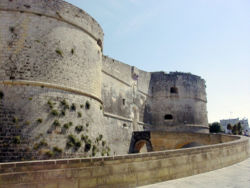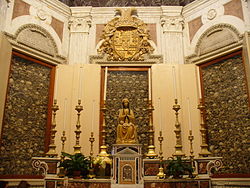- Ottoman invasion of Otranto
-
Battle of Otranto Part of the Ottoman wars in Europe
Ottoman-Hungarian Wars
Date 1480-1481 Location Otranto, Italy Result Ottoman forces seize the city; Christian forces recapture the city Belligerents  Ottoman Empire
Ottoman Empire Kingdom of Naples
Kingdom of Naples
 Kingdom of Aragon
Kingdom of Aragon
 Kingdom of Hungary
Kingdom of HungaryCommanders and leaders Gedik Ahmed Pasha Francesco Largo †
Alphonso II of Naples
Balázs MagyarStrength 18,000 infantry
700 cavalry
70 ships
(possibly 200 ships?)Unknown
Hungary:500 foot soldiers, 300 horsemen[1]Casualties and losses Garrisoned forces surrender Unknown Civilian casualties:
12,000
approx. 1,600 Hungarians (mostly servants)- Reconquista
- Sardinian
- Mahdia
- First
- People's
- 1101
- Norwegian
- Balearic
- Wendish
- Second
- First Swedish
- Third
- 1197
- Livonian
- Fourth
- Albigensian
- Children's
- Fifth
- Sixth
- Prussian
- Second Swedish
- Seventh
- Eighth
- Ninth
- Aragonese
- Third Swedish
- Smyrniote
- Alexandrian
- Savoyard
- Despenser's
- Barbary
- Nicopolis
- Varna
- Otranto
- Lepanto
- Armada
 Book:The Crusades
Book:The Crusades Portal:Crusades
Portal:Crusades
Campaign of Louis I (1) – Treviso – Campaign of Louis I (2) – Nicopolis – Doboj – Radkersburg – Golubac – Lower Danube War – Smederevo – Szeben – Iron Gate – Niš – Zlatitsa - Várna – Kosovo – Nándorfehérvár (1456) – Jajce – Vaslui – Breadfield – Krbava field – Otranto – Mohács (1526) – Campaign of 1527–28 – Little War (1530-52) – Kőszeg – Buda(1541) – Campaign of 1543 – Eger (1552) – Szigetvár – Eger (1596) – Keresztes – Saint Gotthard – Vienna (1683) – Buda (1686) – Mohács (1687) – Slankamen – Zenta – Petrovaradin
- see also:
 Inside Otranto cathedral.
Inside Otranto cathedral.
In 1480 and 1481 the city and fort of Otranto, in Apulia, southern Italy, were held by Ottoman troops.
Contents
Attack
On July 28, 1480, an Ottoman fleet of 128 ships of which 28 were galleys arrived near the Neapolitan city of Otranto in the region Apulia. Possibly these troops came from the siege of Rhodes. On July 29 the garrison and the citizens retreated to the citadel, the Castle of Otranto. On 11 August this was taken by the invaders.
According to Christian historiography a razzia was held to round up the male citizens. Archbishop Stefano Agricoli and others were killed in the cathedral. Bishop Stephen Pendinelli and the garrison commander, count Francesco Zurlo, were sawn in two alive. On August 12, 800 citizens who refused to convert to Islam were taken to the Hill of the Minerva and beheaded.[2] Some of the remains of the 800 martyrs are today stored in Otranto cathedral and in the church of Santa Caterina a Formiello in Naples. The cathedral is said to have been used as a stable after that.[citation needed]
This version has come under severe criticism. From the Turkish side it is disputed that large-scale executions took place; the bones to be found in the Cathedral of Otranto are claimed to be actually those of fighters killed during the Turkish invasion. Italian researchers, on the other hand, conclude that some acts of terror were committed by the Turkish invaders to create panic among the Italians around Otranto.
Some citizens were transported to Albania as slaves.
In August, 70 ships of the fleet attacked Vieste. On September 12, the Monastero di San Nicholas di Casole, which accommodated one of the richer libraries of Europe, was destroyed. In October 1480, the coastal cities of Lecce, Taranto and Brindisi were attacked.
Because of lack of food Gedik Ahmed Pasha returned with most of his troops to Albania, leaving a garrison of 800 infantry and 500 cavalry behind to defend Otranto. It was assumed he would return after the winter.
Response
Since it was only 28 years after the fall of Constantinople, there was some fear that Rome would suffer the same fate. Plans were made for the Pope and citizens of Rome to evacuate the city. Pope Sixtus IV repeated his 1471 call for a crusade. Several Italian city-states, Hungary and France responded positively to this. The Republic of Venice did not, as it had signed an expensive peace treaty with the Ottomans in 1479.
In 1481 an army was raised by king Ferdinand I of Naples to be led by his son Alphonso II of Naples. A contingent of troops was provided by king Matthias Corvinus of Hungary.
Counter attack
The city was besieged starting May 1, 1481. On May 3 the Sultan of the Ottoman Empire, Mehmed II, died, with ensuing quarrels about his succession. This possibly prevented the sending of Ottoman reinforcements to Otranto. So in the end the Turkish occupation of Otranto ended by negotiation with the Christian forces, permitting the Turks to withdraw to Albania. However, quite a few of them were still taken captives when the Christian troops occupied Otranto again.
Aftermath
The number of citizens, said to have been about 20,000 (a figure very much disputed by recent research), had decreased to 8,000[citation needed]. Out of fear of another attack, many of these left the city.
See also
References
- ^ Franz Babinger (1978). "X.". Mehmed the Conqueror and His Time. New Jersey, USA: Princeton University Press. p. 394. ISBN 0 691 09900 6. http://books.google.com/books?id=PPxC6rO7vvsC&pg=PA302&hl=hu&source=gbs_toc_r&cad=3#v=onepage&q&f=false. Retrieved 28 June 2011.
- ^ Bunson, Matthew. "How the 800 Martyrs of Otranto Saved Rome". Catholic Answers. http://www.catholic.com/thisrock/2008/0807fea2.asp. Retrieved 11 August 2011.
External links
- En.otrantopoint.com
- Zum.de
- Borghitalia.it
- Castellipuglia.org
- Uni-mannheim.de
- Cronologia.leonardo.it
- Museomuro.it
- How the Eight Hundred Men of Otranto Saved Rome
- The Crusades Wiki
 Major Ottoman siegesPrusa (1326) • Nicaea (1331) • Nicomedia (1333) • Sofia (1385) • Tarnovo (1393) • Constantinople (1422) • Thessalonica (1422) • Svetigrad (1448) • Constantinople (1453) • Belgrade (1456) • Kruje (1478) • Rhodes (1480) • Otranto (1481) • Cairo (1517) • Rhodes (1522) • Algiers (1529) • Vienna (1529) • Güns (1532) • Tunis (1534) • Baghdat (1534) • Klis (1537) • Corfu (1537) • Diu (1538) • Aden (1538) • Castelnuovo (1539) • Buda (1541) • Nice (1543) • Esztergom (1543) • Van (1547) • Tripoli (1551) • Muscat (1552) • Hormuz (1552) • Eger (1552) • Oran (1556) • Oran (1563) • Malta (1565) • Szigetvar (1566) • Tunis (1574) • Gvozdansko (1578) • Sisak (1593) • Baghdad (1638) • Candia (1669) • Kamenets (1672) • Vienna (1683) • Belgrade (1739)Categories:
Major Ottoman siegesPrusa (1326) • Nicaea (1331) • Nicomedia (1333) • Sofia (1385) • Tarnovo (1393) • Constantinople (1422) • Thessalonica (1422) • Svetigrad (1448) • Constantinople (1453) • Belgrade (1456) • Kruje (1478) • Rhodes (1480) • Otranto (1481) • Cairo (1517) • Rhodes (1522) • Algiers (1529) • Vienna (1529) • Güns (1532) • Tunis (1534) • Baghdat (1534) • Klis (1537) • Corfu (1537) • Diu (1538) • Aden (1538) • Castelnuovo (1539) • Buda (1541) • Nice (1543) • Esztergom (1543) • Van (1547) • Tripoli (1551) • Muscat (1552) • Hormuz (1552) • Eger (1552) • Oran (1556) • Oran (1563) • Malta (1565) • Szigetvar (1566) • Tunis (1574) • Gvozdansko (1578) • Sisak (1593) • Baghdad (1638) • Candia (1669) • Kamenets (1672) • Vienna (1683) • Belgrade (1739)Categories:- Battles involving the Ottoman Empire
- 1480 in Italy
- 1481 in Italy
- Battles involving Hungary
- Battles involving the Kingdom of Naples
- Conflicts in 1480
- Conflicts in 1481
- Mehmed II
Wikimedia Foundation. 2010.
